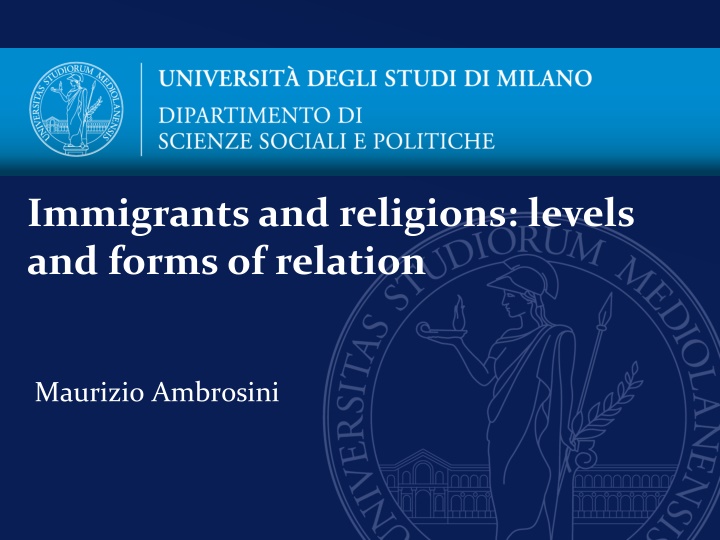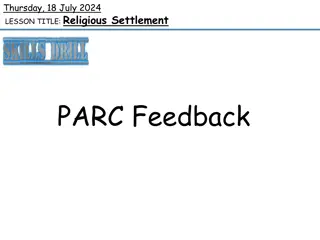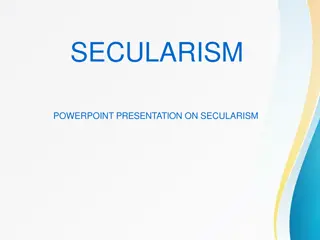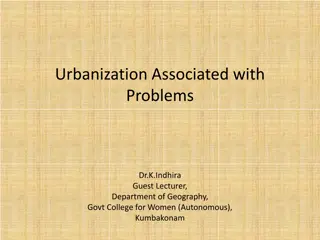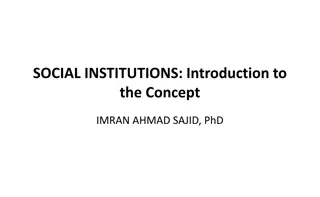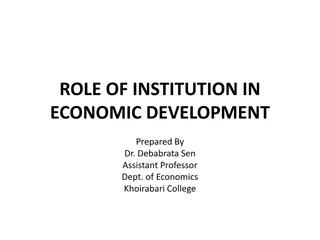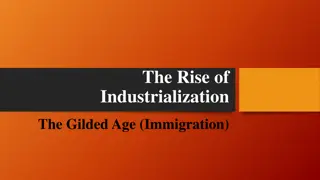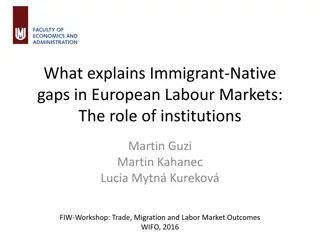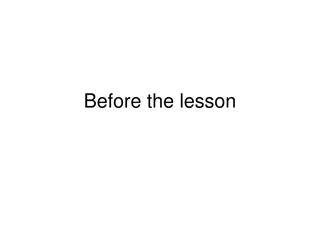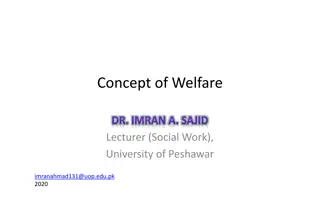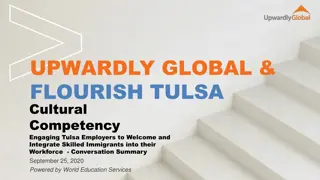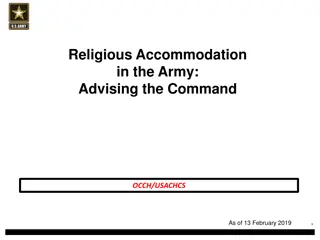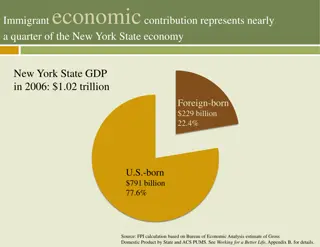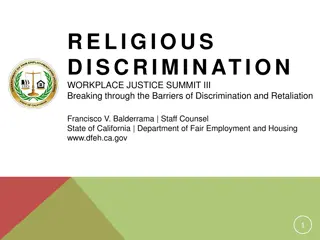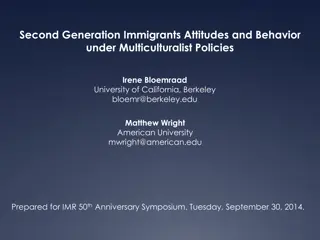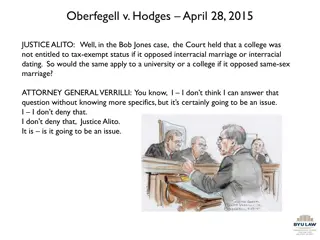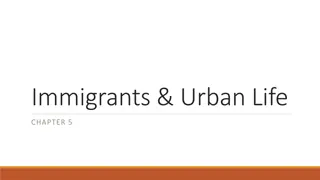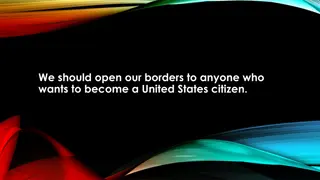The Vital Role of Religious Institutions in Supporting Immigrants
Religions and immigration are interlinked in modern societies, where religions play a significant role in providing services, defending rights, and supporting the social cohesion of immigrants. Mainstream religious institutions serve as key actors in offering assistance, advocating for migrant rights, and filling gaps in public services. Civil societies and religious actors engage through various forms of action like promoting networks, protesting, providing services, and ensuring access to rights. Religious institutions, from both mainstream and minority faiths, serve as sources of refuge, respect, and resources for immigrants, aiding in identity formation and socialization.
Download Presentation

Please find below an Image/Link to download the presentation.
The content on the website is provided AS IS for your information and personal use only. It may not be sold, licensed, or shared on other websites without obtaining consent from the author.If you encounter any issues during the download, it is possible that the publisher has removed the file from their server.
You are allowed to download the files provided on this website for personal or commercial use, subject to the condition that they are used lawfully. All files are the property of their respective owners.
The content on the website is provided AS IS for your information and personal use only. It may not be sold, licensed, or shared on other websites without obtaining consent from the author.
E N D
Presentation Transcript
Immigrants and religions: levels and forms of relation Maurizio Ambrosini
Religions and immigration In the migration field, religions are noticeably recovering an important role that seemed to have disappeared in modern societies From outside: Minority religions can be seen alternatively as a resource or as a threat for social cohesion From above: mainstream religious institutions are relevant actors in migration policies From below: immigrants gather around their religious institutions, symbols and belongings
From above: Who takes care of migrants in the twighlight zone? Restrictions at the borders are combined with a series of conditions that hinder the access of irregular migrants to labour markets and social services (e.g. healthcare, social housing, education) However, irregular migrants remain in the territory, and they have needs and aspirations The restrictions in the public provision of services create an empty space that is filled by alternative providers. In Italy Catholic institutions play a crucial role, and also the Protestant minority isveryactive
Religious institutions servicing the immigrants Mainstream religious institutions in many countries (Southern Europe, USA) are key actors in the provision of services to immigrants and in the cultural and political defence of their rights In the face of governmental border enforcement and a quasi- criminal underground railroad, they have become guardians of migrant rights and dignity, a role they maintain in part through migration counseling, and are part of the ever-expansive and complex social infrastructure that supports migrants in their travels ( Hagan 2008: 84).
Four main forms of action by civil societies and religious actors Promoting networks Protesting and lobbying Producing services and moral support Providing access to rights through legal action (advocacy) A question: non-public provision/ defence of human rights
Religions from below Religious institutions and the immigrants: a source of Refuge, Respect and Resources (Hirschman, 2004) Moreover: identity (who am I?) and socialization (where and how I can meet my compatriots, share and display my cultural belonging?) Adaptation of the religious tradition to the new context: institutional isomorphism, answer to the participants needs Religion is not only religion, but a complex and multifaceted social experience
Why immigrants like their own religious institutions? Places of gathering and socialization Search for the preservation (or re-invention) of the cultural identity Source of help and protection A safe harbour in an alien society: a little piece of Zion in the midst of Babylon (Warner 2000) Possibility of leadership roles Hope to pass their cultural heritage to their children
The case of Islam Many informal halls of prayer (800-900 in Italy) Many self-made imams Several networks, deep divisions in the constituency of the Italian Islam Isomorphism with the Catholic Church (Islamic chaplains in prisons and hospitals) Slow and difficult process of institutionalization (first framework agreement with the Italian government)
The issue of Christian immigrants While the debate focuses on Islam, the majority of immigrants in Italy as in other EU countries are christians But they do not join the religious institutions locally established Church sharing and ethnic chaplanies in the Catholic church (in Italy as in other countries) Self-organization of religious institutions: the evangelical (new Protestant) African or Latin- American churches
Different levels of action of Italian Catholic church In the political game, demanding regularization measures, protesting against anti-immigration policies, lobbying for reform of citizenship law supply of services dedicated to immigrants: language courses, health services, educational support for children, free meals Intermediation in the labour market (especially in domestic services)
Immigrants and the Catholic Church The attitude towards immigrants and asylum seekers is a contentious issue in the Italian Catholic Church (as in the USA) The official discourse is in favour of reception (the Popes, most Bishops, the main associations ) Many people volunteer in various services to immigrants (language schools, health care, support for children education ) Other people, mainly simple church-goers, have taken an adversarial attitude and support anti-immigrant parties
The issue of ecclesiastical citizenship Catholic immigrants gather mainly in national chaplancies, as in other times and in other countries; alternatively, they are passive participants in Italian parishes Church sharing between natives and immigrants Foreigner priests imported to fill the void of clergy Silent exclusion from pastoral councils and national events: no supply, no demand Catholic immigrants are often better connected with the Catholic church in their homeland than with the Catholic church in their town of residence
Interactions between the Italian catholic Church and immigrants Fields of activity Role of the Italian Catholic church Role of immigrants Political debate Defense of immigrant rights, Demand for regularizations Weak Provision of help and services Large involvement in different forms of support Some immigrants work as social workers; small but growing number of volunteers (ethnic chaplancies) Matching laboursupply and demand Mainly informal and especially in the domestic and care sector Brokerage between ethnic networks and catholic institutions Places of gathering Church-sharing, concession of spaces Active role in organizing ethnic chaplancies Active inclusion in communities Separation, different structures for immigrants and natives Preference for separate groups and activities Participation at higher institutional levels Till now, almost generalized exclusion Till now, lack of explicit demand
Conclusions It is necessary to distinguish carefully the different settings where the interactions between native and immigrant believers (included the Catholics) occur, seizing the tensions between them. The same commitment in the reception and the aid feeds the separation, builds invisible social borders: on one side, the people who help, on the other the needy. To recap, despite the commitment in favor of the immigrants, the equality and the integration among believers of different origin is yet a distant goal.
